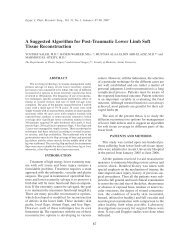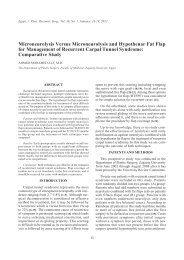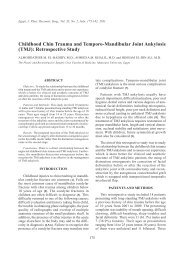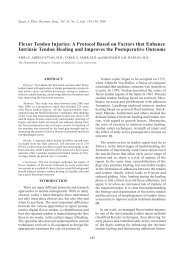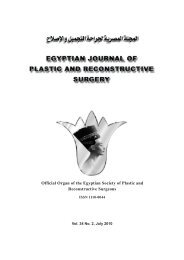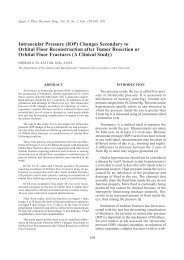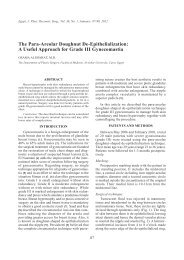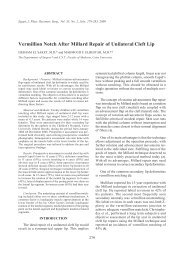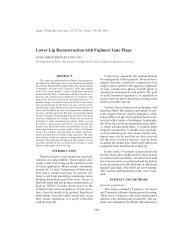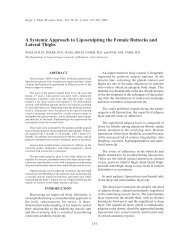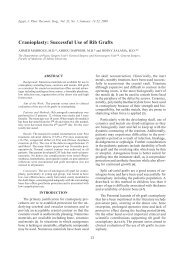The Lateral Supramalleolar Flap for Reconstruction of the ... - ESPRS
The Lateral Supramalleolar Flap for Reconstruction of the ... - ESPRS
The Lateral Supramalleolar Flap for Reconstruction of the ... - ESPRS
Create successful ePaper yourself
Turn your PDF publications into a flip-book with our unique Google optimized e-Paper software.
168 Vol. 34, No. 2 / <strong>The</strong> <strong>Lateral</strong> <strong>Supramalleolar</strong> <strong>Flap</strong> <strong>for</strong> <strong>Reconstruction</strong><br />
<strong>of</strong> <strong>the</strong> main vessel, as well as <strong>the</strong> length and width<br />
required <strong>for</strong> covering <strong>the</strong> skin defect without tension.<br />
Surgical technique:<br />
<strong>The</strong> patient is placed supine with a roll or a<br />
pillow placed under <strong>the</strong> ipsilateral hip. Assessment<br />
<strong>of</strong> <strong>the</strong> defect is carried out and <strong>the</strong> size <strong>of</strong> <strong>the</strong> flap<br />
marked within <strong>the</strong> vascular territory. A hand-held<br />
Doppler probe can be used to locate <strong>the</strong> per<strong>for</strong>ating<br />
branch, and its position is marked. A tourniquet is<br />
used during <strong>the</strong> dissection. <strong>The</strong> ulcer is excised<br />
and <strong>the</strong> defect thoroughly irrigated. <strong>The</strong> margins<br />
<strong>of</strong> <strong>the</strong> flap are <strong>the</strong>n incised down to <strong>the</strong> deep fascia.<br />
<strong>The</strong> deep fascia is incised and <strong>the</strong> flap raised<br />
proximally to distally in <strong>the</strong> sub-fascial plane to<br />
locate <strong>the</strong> per<strong>for</strong>ator. Once <strong>the</strong> per<strong>for</strong>ator is located<br />
and preserved, <strong>the</strong> remainder <strong>of</strong> <strong>the</strong> flap is raised<br />
(Fig. 2). <strong>The</strong> flap is <strong>the</strong>n rotated into <strong>the</strong> defect<br />
based on its vascular pedicle. A drain is placed<br />
under <strong>the</strong> flap and <strong>the</strong> flap can <strong>the</strong>n be sutured in<br />
place. <strong>The</strong> donor can be closed directly if <strong>the</strong> width<br />
<strong>of</strong> <strong>the</strong> flap less than 3cm. O<strong>the</strong>rwise, A split-<br />
(A)<br />
(C)<br />
thickness skin graft is harvested and secured onto<br />
<strong>the</strong> secondary defect (Figs. 1,2,3). <strong>The</strong> wounds are<br />
dressed [4].<br />
RESULTS<br />
<strong>The</strong> lateral supramalleolar flaps were per<strong>for</strong>med<br />
in 16 cases from 2007 to 2009. Of <strong>the</strong>se 10 were<br />
males and 6 were females. Ages ranged from 2<br />
years to 60 years with an average <strong>of</strong> 38. <strong>The</strong> flaps<br />
were successful in 14 cases. <strong>The</strong> take <strong>of</strong> <strong>the</strong> skin<br />
graft on <strong>the</strong> donor defect was good in all cases.<br />
Complications such as marginal necrosis <strong>of</strong> <strong>the</strong><br />
flap were encountered in two cases and were treated<br />
conservatively. Active movement was encouraged<br />
after 1 month.<br />
<strong>The</strong> follow-up period ranged from 1 to 3 years.<br />
In general, <strong>the</strong> texture, thickness and color <strong>of</strong> <strong>the</strong><br />
flaps matched <strong>the</strong> surrounding, and patients were<br />
satisfied with <strong>the</strong> results. <strong>The</strong> thickness <strong>of</strong> <strong>the</strong> flap<br />
was suitable to cover <strong>the</strong> dorsum <strong>of</strong> <strong>the</strong> foot, medial<br />
and lateral malleoli (Figs. 1,2,3).<br />
Fig. (1): (A) Post-traumatic s<strong>of</strong>t tissue defect over <strong>the</strong> distal part <strong>of</strong> tibia that is exposing <strong>the</strong> underlying bone in 36-years old<br />
woman. (B) Design <strong>of</strong> <strong>the</strong> flap. (C) Elevation <strong>of</strong> <strong>the</strong> flap. (D) Final result 3 months later.<br />
(B)<br />
(D)





